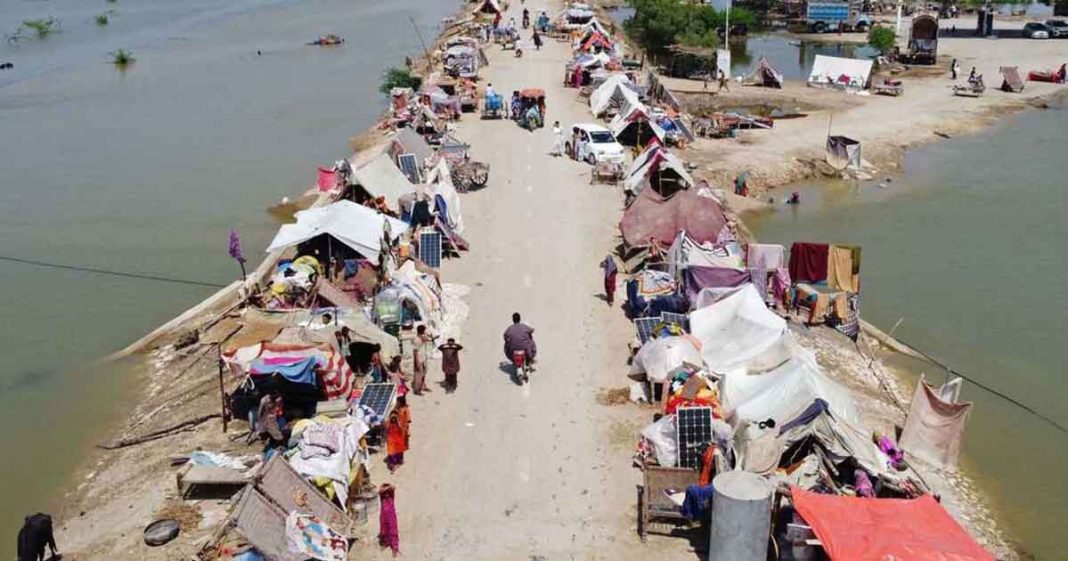In what is probably the greatest climate catastrophe that Pakistan has suffered in recent years – taking the lives of 1596 people, injuring thousands, causing over $30 billion in estimated damages, and overall impacting over 33 million people across the country, leaving many of them homeless.
Tragic stories are being reported across the affected areas, in one case as reported by the New York Times, Nadia, a 29 year old impacted by the floods, describes what she and her family who lived in the village of Wado Khosa, Dadu district went through when nearly a month ago flood water took over their fields. And when residents emerged from their homes early at dawn they found their village surrounded by vast body of water stretching as far as the eyes could see – losing every possession they had.
Many villages have been completely submerged underwater, but in those villages that were lucky enough not to be submerged, residents stay in an attempt to guard what remains of their worldly possessions. Nearly all of the residents of the village are suffering from typhoid or malaria.
Read more: Climate injustice and global apathy: The case of Pakistan
Pakistan produces 1% of the world’s greenhouse gas emissions, however, it is one of the most vulnerable countries to the disastrous effects of climate change. Scientists believe global warming to be responsible for the unprecedented large amounts of rain that caused these tragic floods. Over one third of the country is under water. And experts are currently estimating that it may take between three to six months for the floodwaters to recede.
In the meantime, this leaves millions of people with no homes to live in, who have lost all of their possessions and any means of making money to fend for themselves. Many of these people primarily made their money through agriculture. These floods mean destroyed crops, lost harvests and lost animals. Leaving all of those affected without a way to fund themselves.
The floods outfall affects even those that were not directly affected as a reduction in crop harvested, animals killed creates a shortage of agricultural goods in the country, raising prices of the goods, and putting further strain on an already stressed economy.
Read more: Flood Devastation Across Pakistan
Furthermore, the stagnant waters are causing concerns of a second following disaster as waterborne diseases spread, already having killed an estimated 300 people. Cases of malaria, cholera and others have already started to rise steeply –putting additional stress on a system stretched thin trying to relocate millions as it is. Winter is just around the corner and will bring about new challenges for those affected.
At the end of the day who ends up being responsible for this calamity?
In an economy already suffering from rising inflation, an inability to afford basic necessities, lack of funding for proper infrastructure that would have been able to withstand such floods – and had already been working with the IMF to secure a loan of $7 billion in an attempt to bring the economy back on the right path – is it fair to leave the burden of the coming year’s recuperation to its government alone? Developed countries are responsible for 79% of carbon emissions even today.
And while Pakistanis are grateful to the United States for their help, contributing around $30 million, it does not change the fact that they are the greatest offenders in the global warming crisis. In 2020 the United States produced 5.2 billion metric tons of carbon dioxide equivalent greenhouse gases and is amongst the countries with the highest greenhouse gases emissions per person.
Read more: Floods are seasonal but debts are perennial!
Should Pakistan be suffering for others mistakes? Is it not the moral duty of the first world countries, that are far more developed and certainly wealthier, to assist in solving the global issue that they have helped to create? By partaking in measures such as forgiving debt as Prime Minister Shehbaz Sharif has requested? These are few questions that the Rich North needs to ask itself and answer to the satisfaction of those being impacted by their actions.
The views expressed in this article are the author’s own and do not necessarily reflect the editorial policy of Global Village Space.














